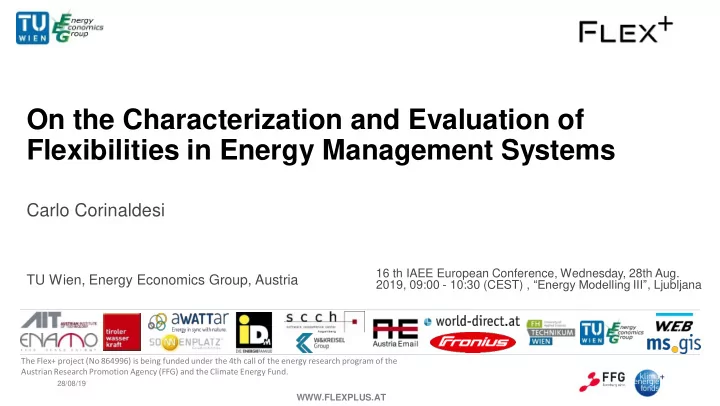

On the Characterization and Evaluation of Flexibilities in Energy Management Systems Carlo Corinaldesi 16 th IAEE European Conference, Wednesday, 28th Aug. TU Wien, Energy Economics Group, Austria 2019, 09:00 - 10:30 (CEST) , “Energy Modelling III” , Ljubljana The Flex+ project (No 864996) is being funded under the 4th call of the energy research program of the Austrian Research Promotion Agency (FFG) and the Climate Energy Fund. 28/08/19 WWW.FLEXPLUS.AT
About the Project „Flex+“ Target country: Austria • Start: 05.2018 • Duration: 36 Months (04.2021) • Coordinator: AIT Austrian Institute of Technology GmbH (AIT) • 15 Partners • The Flex+ project (No 864996) is being funded under the 4th call of the energy research program of the Austrian Research Promotion Agency (FFG) and the Climate Energy Fund. 28/08/19 WWW.FLEXPLUS.AT
Motivation “The need for flexibility in the grid is increasing, because of the growing • share of renewable energy resources and it’s volatility. (R.A. Verzijlbergh et al. 2017)“ “The power system is moving from a central to a decentralized energy • system. The new system includes more distributed generation, energy storages and requires a more active involvement of consumers, e.g. through demand response. (P. D. Lund et al. 2015 )“ “In the last years, power system regulators and operators create • conditions for encouraging the participation of the demand-side into reserve markets lowering the minimum size of the balancing power market bids. (R. J. Bessa et al. 2013 )“ 28/08/19 | 3
Literature “A simple and exhaustive description of flexibilities is needed to efficiently coordinate • and aggregate multiple flexible actors (Valsomatzis et al. 2017 ).“ Research question 1: How to formulate flexibilities of different technologies? Hao et al. (2015) models the flexibilities as virtual battery models. This work • improves this approach by the introduction of new technologies and functionalities. “The profits of aggregated RES cannot be suitably distributed (e.g., per capacity or • generated electricity) without the need of advanced algorithms (P. Chakraborty et al. 2016 ).“ Research question 2: How to allocate the value of aggregated flexibilities among the flexible technologies? Saad et al. (2012) conclude that (cooperative) game theoretical methods are a • promising tool to share the value. This work uses the Shapley Value. 28/08/19 | 4
Investigated Use Case: Objective Function: minimize WEB, Windenergie AG, Pfaffenschlag, Austria Coordinates: N 48.843594, E 15.200681 28/08/19 | 5
Batterie 28/08/19 | 4
Flexibility Modelling: Batteries (II)
Elektromobilität 28/08/19 | 6
Flexibility Modelling: Electric Vehicles MC … Managed Charging VTG … Vehicle-to-Grid 28/08/19 | 9
Flexibility Modelling: Electric Vehicles
PV 28/08/19 | 8
Flexibility Modelling: Photovoltaic Panel
Real life Case study: WEB, Windenergie AG, Pfaffenschlag, Austria Flexibilities Optimization Framework: 30 charging stations with 3740 charging The Optimization problem is • processes implemented in Julia and 1 Battery (80 kWh, 80 kW) Python and solved with the • 6 Photovoltaic panels (90 kW p ) Gurobi solver. • This case study examines the potential value that the flexibilization of the technologies of an Energy Management System may create in a period of one year. 28/08/19 | 13
The market oriented optimization Framework The aim is to optimize the flexible power flows of multiple loads and • generators on multiple energy markets with different market designs. Use Case 1: Considered energy markets: Day-ahead spot market (EPEX) • Intraday spot market (EPEX) • Secondary reserve market (APG) • Perfect load and price foresight. • 28/08/19 | 14
Use Case 1: Market-oriented optimized flexible power flows of the Energy Management System
The market oriented optimization Framework The aim is to optimize the flexible power flows of multiple loads and • generators on multiple energy markets with different market designs. Use Case 1: Use Case 2: Considered energy markets: Considered energy markets: Day-ahead spot market (EPEX) Day-ahead spot market (EPEX) • • Intraday spot market (EPEX) Intraday spot market (EPEX) • • Secondary reserve market (APG) • Imperfect load and price foresight. • Perfect load and price foresight. • 28/08/19 | 16
Use Case 2: Market-oriented optimized flexible power flows of the Energy Management System
Allocation of the Created Value via Shapley value • The Shapley value concept offers a solution to allocate the created value among multiple players. • Energy Management System with flexible technologies: 𝑗 ϵ 𝑇 ⊆ 𝐽 = {Electric vehicles , Photovoltaics, Batteries} • The Energy Management System with a set of flexibilized technologies 𝑇 ⊆ 𝐽 generates value 𝑤 𝑇 . 𝑤 𝑇 Flexibilized set of technologies S: Created value in € {Photovoltaics} 7 y 𝑗 𝑗 Technology Shapley Value in € {Electric vehicles} 1287 {Batteries} 3388 {Photovoltaics} 8 {Photovoltaics, Electric vehicles} 1296 {Electric vehicles} 1454 {Photovoltaics, Batteries} 3395 {Batteries} 3555 [Electric vehicles, Batteries} 5008 {Photovoltaics, Electric vehicles, Batteries} 5017 28/08/19 | 18
Conclusions Our work presents a comprehensive overview of modeling and evaluating • the flexibilities of an Energy Management System. We describe multiple flexible technologies as virtual batteries and • implement them in a mathematical optimization problem. We used the game theoretic solution concept of Shapley value to assign a • value to each flexible technology based on its contribution. We applied our proposed methods to a real-life case study in Austria with • metered data. Our work shows, how aggregating flexibilities results in energy costs • reduction. 28/08/19 | 19
It's all very well to have principles, but when it comes to money you have to be flexible. ( Eugene Ormandy - Hungarian-American conductor and violinist ) Thank you for your attention Carlo Corinaldesi → Follow up the Project on https://www.flexplus.at/! 16 th IAEE European Conference, Wednesday, 28th Aug. TU Wien, Energy Economics Group, Austria 2019, 09:00 - 10:30 (CEST) , “Energy Modelling III” , Ljubljana The Flex+ project (No 864996) is being funded under the 4th call of the energy research program of the Austrian Research Promotion Agency (FFG) and the Climate Energy Fund. 28/08/19 WWW.FLEXPLUS.AT
Recommend
More recommend